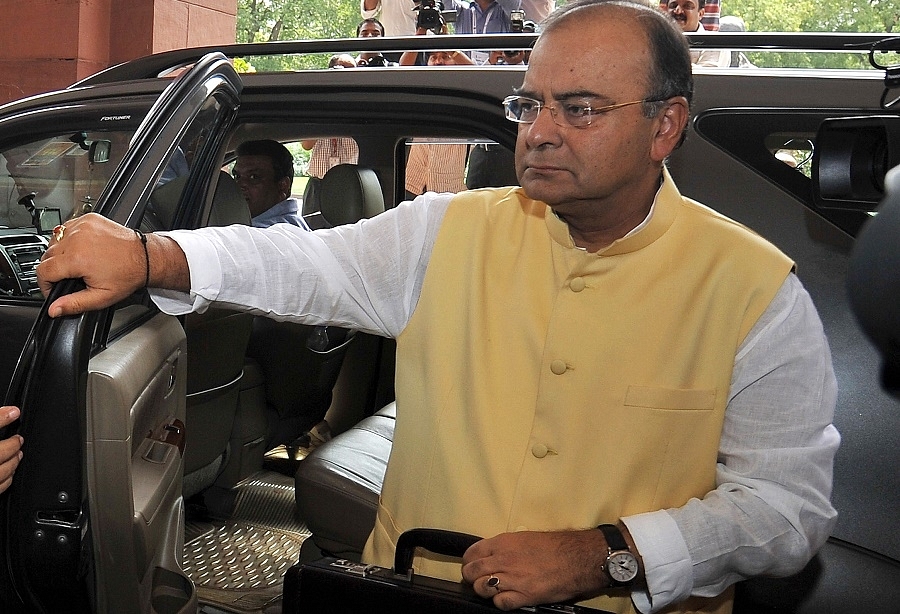Economy
Where is the Capital Expenditure Push, Mr Jaitley?
- The huge increase in Plan expenditure is driven by Plan revenue expenditure – 20.4 per cent. Plan capital expenditure growth is only 2.9 per cent.
- Capital expenditure as a percentage of GDP is set to fall – from 1.75 per cent in 2015-16 to 1.63 per cent in 2016-17.
- No doubt this is because of the Seventh Pay Commission and OROP payouts and so is understandable, but why not say that upfront?

India’s Finance Minister Arun Jaitley (RAVEENDRAN/AFP/Getty Images)
Does Budget 2016-17 really push capital expenditure in a big way? Finance minister Arun Jaitley said he was budgeting a huge increase in Plan expenditure vis-à-vis Non Plan. Well that was correct – Plan expenditure is set to grow 15 per cent in 2016-17 and Non Plan only 9 per cent.
But he also spoke about moving away from the Plan-Non Plan categorisation of expenditure from the coming year, and that a revenue-capital categorisation is better. So why not put his numbers to test on that score?
Then it turns out that the huge increase in Plan expenditure is driven by Plan revenue expenditure – 20.4 per cent. Plan capital expenditure growth is only 2.9 per cent.
Slice these numbers from another angle – total expenditure and then revenue and capital. Total expenditure growth is 10.7 per cent and within that, revenue expenditure is set to grow 11.8 per cent and capital expenditure only 3.9 per cent. Capital expenditure as a percentage of GDP is set to fall – from 1.75 per cent in 2015-16 to 1.63 per cent in 2016-17.
No doubt this is because of the Seventh Pay Commission and OROP payouts and so is understandable, but why not say that upfront?
The growth numbers are also a bit problematic. Jaitley expects a nominal growth of gross domestic product (GDP) in 2016-17. When asked at the post-budget press conference what the real growth target was, all he would say was that he was going by the growth number in the Economic Survey 2015-16.
Now the Survey estimated growth in 2016-17 in the range of 7-7.5 per cent. So, what does that imply for inflation? Is the government expecting the deflator to be in the range of 3.25-4 per cent? There is something that doesn’t quite add up here. Is the higher GDP assumption meant to make the deficit numbers look good?
If the economy doesn’t grow at the desired rate, will the projected 12 per cent growth in excise collection and 10 per cent in service tax come about?
Receipts from disinvestment in 2016-17 are projected at Rs 56,500 crore, more than double of the revised estimates of Rs 25,312 crore in 2015-16, but less than the Rs 69,500 crore budgeted for the current financial year last February. The expected receipts from strategic disinvestment in 2016-17 – Rs 20,500 crore – are also lower than the Rs 28,500 crore budgeted for 2015-16.
How good is the government’s expenditure management this year? The government has been claiming a greater emphasis on capital expenditure and initial figures put out by the Comptroller and Auditor General seemed to validate that. The budget documents show revenue expenditure in 2015-16 will be 0.7 per cent higher than the budget estimates. That sounds good, but capital expenditure is shown as 1.5 per cent lower than budget estimates.
The share of subsidies in total expenditure is set to fall – from 14.4 per cent in 2015-16 to 12.6 per cent in 2016-17. This will be driven mainly by a 10 per cent fall in petroleum subsidy. Food and fertiliser subsidy fall by only 3 per cent each. The food subsidy bill in the current year saw a 12 per cent increase over the budget estimates of Rs 1,24,419 crore but that was because the budget estimates made last February did not factor in a full rollout of the National Food Security Act (NFSA). At that time, only 11 states were on board. Almost all states now are on board.
There may be more devils emerging from the fine print of the budget documents.
Introducing ElectionsHQ + 50 Ground Reports Project
The 2024 elections might seem easy to guess, but there are some important questions that shouldn't be missed.
Do freebies still sway voters? Do people prioritise infrastructure when voting? How will Punjab vote?
The answers to these questions provide great insights into where we, as a country, are headed in the years to come.
Swarajya is starting a project with an aim to do 50 solid ground stories and a smart commentary service on WhatsApp, a one-of-a-kind. We'd love your support during this election season.
Click below to contribute.
Latest